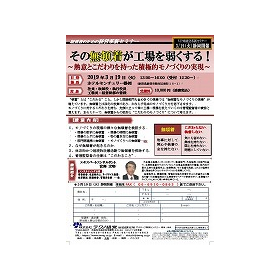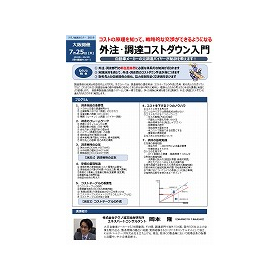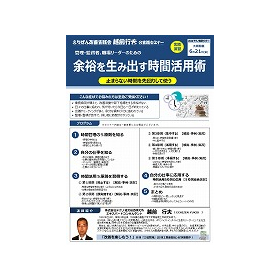- Publication year : 2019
1~9 item / All 9 items
Displayed results
Added to bookmarks
Bookmarks listBookmark has been removed
Bookmarks listYou can't add any more bookmarks
By registering as a member, you can increase the number of bookmarks you can save and organize them with labels.
Free membership registration
Contact this company
Contact Us Online1~9 item / All 9 items

"Directly solving your factory layout concerns!" ◆ If you are planning to establish a new factory, change the factory layout, or relocate the factory, what kind of structure should you adopt? ◆ Experienced personnel have already retired... there are no experienced individuals... where should you start? What are the legal issues? ◆ You want to update equipment, improve factory efficiency, and enhance the working environment. ◆ How can you effectively renew? 【Seminar Features】 → Veteran consultants will clearly lecture on key points. → We will provide specific advice on your factory layout concerns and questions. → A realistic seminar that includes the instructor's personal experiences (successes and failures). 【Program】 1. Common concerns in the manufacturing industry. 2. 10 steps to factory layout design. 3. Overview of factory layout design tasks. 4. Detailed design techniques for layouts that thoroughly eliminate waste. 5. Effective ways to engage construction contractors that will surprise you. 6. What a factory should look like looking ahead 20 to 30 years. 【Main Target Participants】 Those responsible for production technology, factory planning, updating factory layouts, and planning factory relocations, new establishments, or overseas expansions. * Seminar hosted by Techno Management Web Solutions.
Added to bookmarks
Bookmarks listBookmark has been removed
Bookmarks listYou can't add any more bookmarks
By registering as a member, you can increase the number of bookmarks you can save and organize them with labels.
Free membership registration
"International journalist Tohru Kumagai speaks on true work style reform!" Japan's labor productivity ranks lowest among the G7 countries. In contrast, Germany, a leading manufacturing nation, maintains a high level of labor productivity that is about 1.5 times that of Japan. What is the secret behind German companies that can achieve high economic performance while taking long vacations and having zero overtime? Compared to manufacturing sites, it is said that the productivity of white-collar workers in Japanese companies is very low. With overtime regulations due to work style reform and a labor shortage in the field, improving productivity in indirect departments is a critical issue. In this seminar, we will introduce the latest developments in German manufacturing, the work styles in German society, and thoroughly analyze the secrets and characteristics that lead to high productivity. We will also present practical insights and approaches to successfully reform indirect departments from the perspective of behavioral science, as well as methods to enhance workplace motivation and examples of indirect reforms that connect to management numbers.
Added to bookmarks
Bookmarks listBookmark has been removed
Bookmarks listYou can't add any more bookmarks
By registering as a member, you can increase the number of bookmarks you can save and organize them with labels.
Free membership registration
"Tonjaku" means "to be particular about" something. However, in many workplaces, including indirect departments, there is an increasing trend of "indifferent manufacturing environments." Indifference is the abandonment of depth, which will inevitably reduce future manufacturing capabilities. It is the responsibility of management supervisors to have a commitment to manufacturing and to lead the continuous transformation of factories and workplaces. In this seminar, we will consider how to break free from indifference and focus on "committed manufacturing." ------------------------------------------------- 【Lecture Content】 1. Examine various forms of indifference in manufacturing environments - Indifference to workplace metrics - Indifference to time in the workplace - Indifference to waste in the workplace - Indifference to the arrangement of items - Indifference to interdepartmental collaboration - Indifference to manufacturing... etc. 2. Why does indifference occur? 3. Eliminate indifference through systematic and continuous improvement activities 4. The job of management supervisors is to "be particular about" things.
Added to bookmarks
Bookmarks listBookmark has been removed
Bookmarks listYou can't add any more bookmarks
By registering as a member, you can increase the number of bookmarks you can save and organize them with labels.
Free membership registration
"A former procurement buyer from an automobile manufacturer shares their secrets!" **Objectives and Features** (1) Gain systematic knowledge necessary for new personnel in the outsourcing and procurement department. (2) Acquire cost reduction techniques for outsourcing and procurement through practical exercises. (3) Learn negotiation skills to strengthen trust and build cooperative relationships with business partners. --- Reducing manufacturing costs is a key strategy for improving profitability. This seminar will scientifically clarify aspects that have relied on the intuition and experience of outsourcing and procurement personnel, such as appropriate assessment of procurement prices, creation and utilization of cost tables, and negotiation know-how with business partners. Participants will learn the concepts and methods for standardization through lectures and exercises. The instructor, who has been active on the front lines as a procurement buyer in the automotive manufacturing industry and has gained extensive experience and achievements, will clearly explain how to promote cost reduction in outsourcing and procurement. --- **Program** 1. Importance of the procurement function 2. Procurement framework 3. Development of procurement strategies 4. Basic knowledge of costs 5. Importance of cost tables 6. Seven know-hows for reducing costs 7. Basic knowledge of procurement --- *Acquire knowledge from the basics of outsourcing and procurement strategies to cost knowledge and cost table creation through exercises!*
Added to bookmarks
Bookmarks listBookmark has been removed
Bookmarks listYou can't add any more bookmarks
By registering as a member, you can increase the number of bookmarks you can save and organize them with labels.
Free membership registration
■Objectives and Features 1) Understand the principles and fundamentals of "5S and Visualization," which are the basics of manufacturing! 2) Learn the know-how to apply it to standardization of work, setup efficiency, and prevention of mistakes! 3) Gain hints on how to effectively utilize "5S and Visualization" in internal improvement activities! -- The purpose of "5S and Visualization" is not just to organize and clean up the workplace. The essence of "5S and Visualization" lies in linking it to internal standardization, setup improvements, prevention of human errors, and efficiency in internal logistics. In this seminar, participants will learn practical methods to utilize "5S and Visualization" for improving productivity and quality through exercises. -- 1. Thoroughly understand 5S! 2. Learn the correct approach to implementing 5S. 3. What is Visualization? 4. The workplace changes with 5S and Visualization! 5. Summary 6. Q&A (Individual consultations) *If you have the following symptoms, please take this course urgently! ◆ Unable to organize and tidy up work ◆ Spending too much time searching for items and making many mistakes ◆ 5S has become just about cleaning ◆ Improvement activities are stagnating, and no ideas are coming up ◆ The workplace is not presentable to customers*
Added to bookmarks
Bookmarks listBookmark has been removed
Bookmarks listYou can't add any more bookmarks
By registering as a member, you can increase the number of bookmarks you can save and organize them with labels.
Free membership registration
■ Seminar Objectives 1) We will introduce how to promote "simple automation" using a straightforward mechanism without incurring costs. 2) You will learn the "principles of automation" utilizing the characteristics of karakuri principles (such as pulleys, levers, and cams). 3) Numerous concrete practical examples will be presented, and we will provide advice on how to apply them in your own company. --- In the seminar, we will explain the concepts that underpin automation and how to promote simple automation based on real examples using karakuri principles such as pulleys, levers, and cams. We will introduce mechanical mechanisms that require no costs and are easy to modify and repair. Please master the essential elements of on-site improvements that enhance efficiency in assembly, processing, and transportation, eliminate waste, and achieve the three goals of "easy, fast, and simple." ■ Program 1. To promote effective automation 2. "Important points" to know before automation 3. Concept of automation for "assembly work" 4. Concept of automation for "machining" 5. Concept of automation for "transportation work" 6. Challenge "automation" with karakuri principles! *For detailed program information, please refer to the brochure. ■ You will learn how to promote "simple automation" using karakuri principles! 'Assembly work', 'Machining', 'Transportation work'
Added to bookmarks
Bookmarks listBookmark has been removed
Bookmarks listYou can't add any more bookmarks
By registering as a member, you can increase the number of bookmarks you can save and organize them with labels.
Free membership registration
【Aim of the Seminar】 1) We will introduce how to promote "simple automation" without incurring costs using a simple mechanism. 2) You will learn the "principles of automation" utilizing the characteristics of karakuri principles (such as pulleys, levers, and cams). 3) We will present numerous concrete practical examples and provide advice on how to apply them in your own company. ----- In the seminar, we will explain the concepts that underpin automation and how to promote simple automation using the karakuri principles applied to pulleys, levers, and cams, based on real examples. We will introduce mechanical mechanisms that use ingenuity without incurring costs and are easy to modify and repair. Please master the essential elements of on-site improvement that realize efficiency in assembly, processing, and transportation, eliminating waste and achieving the three key aspects of "easy, fast, and simple." ----- 【Program】 1. To promote effective automation 2. "Important points" to know before automation 3. Concept of automation for "assembly work" 4. Concept of automation for "machining" 5. Concept of automation for "transportation work" 6. Challenge "automation" with karakuri principles! ----- ■ You will understand how to promote "simple automation" using karakuri principles! 'Assembly work' 'Machining' 'Transportation work'
Added to bookmarks
Bookmarks listBookmark has been removed
Bookmarks listYou can't add any more bookmarks
By registering as a member, you can increase the number of bookmarks you can save and organize them with labels.
Free membership registration
~ Using time that doesn't stop by getting ahead of it ~ 【If you are struggling with any of the following symptoms, please enroll urgently!】 - Increased workload, leaving no room for improvement activities or coaching subordinates - Constantly busy with daily tasks, only to realize the day has ended - Overwhelmed by numerous meetings and the need to create extra materials - Struggling with organization and spending too much time searching for things -------------------------------------------------------------- 【Program】*Details are provided in the brochure or on the website (1) Learn the 5 principles of time management (2) Understand your own work (3) Master the 5 principles of time management 1. First Principle (Eliminate) [Explanation, Examples, Exercises] 2. Second Principle (Implement Immediately) [Explanation, Examples, Exercises] 3. Third Principle (Concentrate) [Explanation, Examples, Exercises] 4. Fourth Principle (Utilize) [Explanation, Examples, Exercises] 5. Fifth Principle (Prepare) [Explanation, Examples, Exercises] (4) Apply to your own work Application of the 5 principles of time management [Comprehensive Exercises on the 5 Principles] (5) Summary *The content of the seminar may be subject to change.
Added to bookmarks
Bookmarks listBookmark has been removed
Bookmarks listYou can't add any more bookmarks
By registering as a member, you can increase the number of bookmarks you can save and organize them with labels.
Free membership registration
Tonjaku" means to be particular about something. However, in many workplaces, including indirect departments, there is an increasing trend of "careless manufacturing environments." Carelessness is the abandonment of depth and will inevitably reduce future manufacturing capabilities. It is the responsibility of management supervisors to have a commitment to manufacturing and to lead the continuous transformation of factories and workplaces. In this seminar, we will consider how to break free from carelessness and focus on "committed manufacturing." ------------------------------------------------- 【Lecture Content】 1. Examine various forms of carelessness in manufacturing environments - Indifference to workplace metrics - Indifference to time in the workplace - Indifference to waste in the workplace - Indifference to the arrangement of items - Indifference to interdepartmental collaboration - Indifference to manufacturing... etc. 2. Why does carelessness occur? 3. Eliminate carelessness through systematic and continuous improvement activities 4. The job of management supervisors is to "be particular.
Added to bookmarks
Bookmarks listBookmark has been removed
Bookmarks listYou can't add any more bookmarks
By registering as a member, you can increase the number of bookmarks you can save and organize them with labels.
Free membership registration